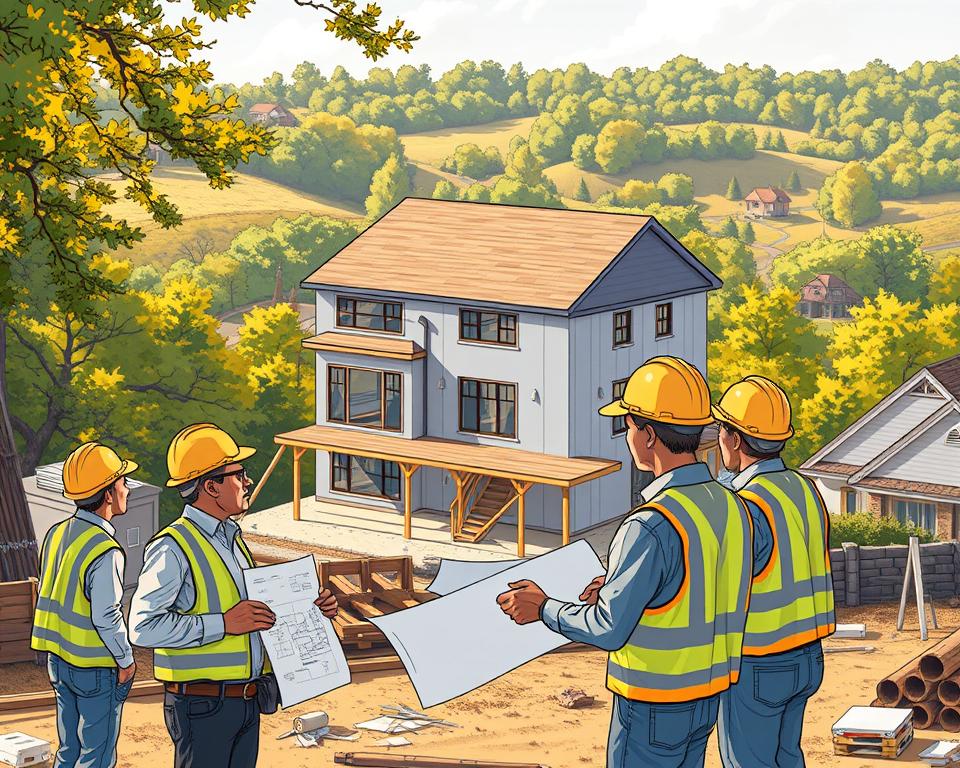Earth Bound Building: Straw-bale Building in Anne Arundel
Were you aware how houses constructed from eco-friendly materials may lower energy costs as much as 50%? This is just one reason why more homeowners choose eco-conscious design. Earth Bound Building, based in Anne Arundel, is pioneering this movement, delivering forward-thinking and low-energy projects.
Using bio-based materials such as straw bales inside timber frames, Earth Bound Building creates heavy timber construction Anne Arundel which are both planet-conscious and remarkably robust. The team’s approach integrates heritage craftsmanship with current sustainable practices, so that every project satisfies the strictest standards of sustainability.
Earth Bound Building’s differentiator comes from their collaborative process and strong community involvement. They collaborate with homeowners to craft spaces that express their principles and needs. When you want a eco-conscious way to build, Earth Bound Building is your go-to partner in Anne Arundel.
What is Strawbale Construction?
Straw, often seen as waste, is transforming eco-design. Straw-bale methods utilizes stacking bales within timber frames to build walls that are both highly insulating and structural. This method repurposes an agricultural byproduct, which makes it a sustainably sourced and low-impact choice.
Straw comes from grain crops such as wheat, rice, or barley. Rather than burning or discarding it, farmers often provide it for construction. This helps reduce agricultural waste and supplies a sustainable material for homes. The method is straightforward, well-suited to owner-builders and community projects.
One of the distinctive features of straw bale walls is their insulation performance. Versus traditional materials like fiberglass or wood, straw bales have a higher R-value. In practice, this means they hold heat better, producing lower energy costs. Here’s a quick comparison:

| Material Type | Thermal R-Value/inch |
|---|---|
| Straw Bale | R-2.38 |
| Fiberglass | R-2.20 |
| Wood | R-1.41 |
Another advantage is the use of chemical-free materials. Straw bales are absent of harmful chemicals, encouraging cleaner indoor air quality. This makes them a safe choice for families and eco-aware homeowners.
In summary, straw bale construction is a eco-friendly, energy-efficient, and health-conscious option. It’s a perfect fit for those aiming to reduce their environmental footprint while gaining long-term savings.
Why Choose Earth Bound Building for Your Project?
Choosing the right team for your green project can make all the difference. Earth Bound Building is a top choice in eco-friendly design, delivering modern solutions tailored to your needs. Our approach combines leading techniques with a genuine respect for the environment.
Commitment to Sustainability
Earth Bound Building prioritizes sustainable practices in every project. They use CO₂-locking straw and low-carbon materials to reduce environmental impact. Beyond helping the planet but also supports long-term savings for homeowners.
Their partnerships with regional farmers ensure ethically sourced materials. By strengthening local agriculture, they build a circular economy. This commitment to sustainability sets them apart in the industry.
Local Expertise in Anne Arundel
With deep roots in Anne Arundel, Earth Bound Building is familiar with the unique needs of the area. They are familiar with local climate conditions, permitting processes, and supply chains. This expertise delivers smooth project execution and compliance with regulations.
Their tailored designs honor Anne Arundel’s aesthetic preferences while meeting strict building codes. Whether it’s a residential or commercial project, they deliver results that blend seamlessly with the local environment.
| Category | Earth Bound Building | Typical Approaches |
|---|---|---|
| Sourcing of Materials | Local, ethically sourced straw | Imported, high-embodied energy materials |
| Energy Efficiency | High R-value insulation | Standard insulation |
| Environmental Impact | Low carbon footprint | Higher emissions |
Earth Bound Building’s focus to sustainability and local expertise makes them the ideal choice for your next project. Their modern practices and community-focused approach provide a seamless and eco-friendly experience.
The Benefits of Straw bale Building Anne Arundel
Sustainable architecture is growing rapidly for its ability to unite innovation with environmental responsibility. One of the most promising methods in this field is the use of straw bales. This approach offers a range of benefits, from energy efficiency to eco-friendliness, making it an smart option for modern homeowners.
Energy Efficiency and Cost Savings
Straw bale walls deliver excellent insulation, beating traditional materials like fiberglass. With an R-value of 2.38 per inch, they help stabilize indoor temperatures, reducing the need for heating and cooling. This can result in energy savings of as much as 50–75%.
Over time, these savings offset the initial construction costs. Homeowners enjoy lower energy bills while supporting a greener planet. Here is how straw bales measure up to other materials:
| Material Type | R-Value (per inch) |
|---|---|
| Straw Bale | R-2.38 |
| Fiberglass | R-2.20 |
| Wood | R-1.41 |
Eco-Friendly and Renewable
Straw is a regenerative resource that returns each season, in contrast to timber, which requires decades to grow. Using straw in construction reduces agricultural waste and fosters a circular economy. It also stores CO₂ in the walls, helping to fight climate change.
Additionally, straw bale walls are non-toxic, supporting better indoor air quality. They are also fire-resistant, with plastered walls exceeding 2-hour fire ratings. This makes them a dependable and eco-friendly choice for any project.
By choosing straw bale construction, you’re not just building a home—you’re supporting a more wholesome, more sustainable future.
How Straw-bale Homes Are Constructed
There are a few ways to construct sustainable homes using straw bales. Each method delivers unique benefits, from structural support to efficient installation. Comparing these approaches can help you select the best approach for your project.
Nebraska Style vs. In-Fill Wall Systems
The Nebraska Style is a heritage method where straw walls serve as the primary structural support. This approach is well-suited for smaller homes and emphasizes simplicity. The bales are stacked directly on the foundation, reducing the need for the need for additional supports or frames.
In contrast, In-Fill Wall Systems use timber frames to carry the structural load. The bales are installed within these frames, allowing for faster roof installation and enhanced design flexibility. This method is common for larger projects where customization is key.
Prefabricated Straw Wall Panels
Prefabricated panels are a modern innovation in straw bale construction. These factory-built panel sections minimize on-site labor and minimize weather-related risks. They are designed for quick assembly, making them a practical choice for time-sensitive projects.
Here’s a comparison of the three methods:
| Method | Key Features | Ideal For |
|---|---|---|
| Nebraska Style | Load-bearing bales, simple build | Small homes |
| In-Fill Systems | Timber frames, design flexibility | Larger projects |
| Prefabricated Panels | Factory-built, reduced assembly time | Quick installations |
Each method has its strengths, and the choice is guided by your project’s needs. Whether you lean toward traditional techniques or modern innovations, straw bale construction offers a eco-friendly and effective solution.
Common Myths About Straw-bale Construction
Many people hold myths around sustainable materials like straw. These myths often discourage homeowners from exploring eco-friendly options. Let’s clear up some of the most common concerns.
Fire Resistance and Safety
One of the biggest myths is that straw is a fire hazard. In reality, compressed bales lack the oxygen needed to burn. Lab tests indicate that plastered straw walls can withstand over two hours of fire exposure. This outperforms the fire resistance of many traditional materials like lumber.
Plaster acts as a protective barrier, sealing the bales and preventing ignition. This makes straw-based structures very safe. Below is a quick comparison:
| Material | Fire Rating |
|---|---|
| Plastered Straw | 2+ hours |
| Wood | 1 hour |
Pest and Moisture Management
Another concern is pests. Straw has zero nutritional value, so it doesn’t attract rodents and insects. When finished with plaster, it becomes nearly impossible for pests to penetrate. This removes one of the most common problems homeowners worry about.
Moisture is also manageable with proper design. Elevated foundations, wide eaves, and vapor-permeable finishes such as vapor-permeable stucco reduce the risk of rot. Modern techniques ensure these homes remain durable for decades.
Compare how straw stacks up against traditional materials in moisture control:
| Material | Moisture Control |
|---|---|
| Straw with Proper Design | High |
| Wood without Treatment | Low |
By dispelling these myths, it’s clear that straw-based structures are a secure, sustainable, and long-lasting choice for modern homes.
Is a Straw-bale Home Right for You?
Designing a home that’s both appealing and green is well within reach. With unique features such as deep window niches and rounded designs, eco-friendly homes offer endless possibilities. Let’s explore why this could be the perfect choice for you.
Customization and Aesthetic Appeal
One of the signature features of these homes is their design flexibility. You can create organic walls, arched doorways, and built-in shelving to reflect your style. The thick walls also deliver strong acoustic privacy, keeping interiors tranquil.
Rustic plaster finishes bring a unique charm, merging modern aesthetics with natural elements. Whether you’re an artist or an eco-conscious family, these homes can be crafted to express your personality and needs.
Long-Term Benefits and Sustainability
Opting for a sustainable home isn’t just about the environment—it’s also a savvy financial decision. These homes cost less to maintain over time, thanks to their energy efficiency. With reduced heating and cooling bills, you’ll see significant savings on utilities.
Additionally, green homes may be eligible for tax incentives and have higher property values. Here is a quick comparison of lifecycle costs:
| Cost Area | Strawbale Homes | Conventional Homes |
|---|---|---|
| Energy Costs | Lower | Higher |
| Upkeep | Minimal | Regular |
| Resale Value | Higher | Standard |
Earth Bound Building’s discovery process makes sure your goals match your budget. Whether you’re looking for an off-grid retreat or a family home, they’ll guide you every step of the way.
The Final Word
Adopting eco-friendly living starts with the right materials and the right team. Straw bale homes provide unmatched benefits, from energy efficiency to longevity. They cut costs while supporting the environment, making them a savvy choice for modern homeowners.
Earth Bound Building is a leader in sustainable building in Anne Arundel. Their expertise delivers every project meets the highest standards of quality and eco-friendliness. Become part of the growing community of homeowners who’ve adopted this modern approach.
Prepared to move forward? Reach out to Earth Bound Building for a custom consultation. Take part in their workshops or tour completed projects to see the benefits firsthand. Building with straw not only creates a house but also supports regenerative agriculture and local economies.
